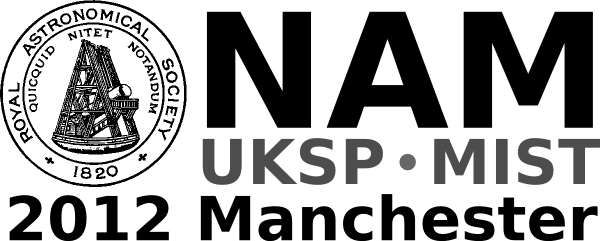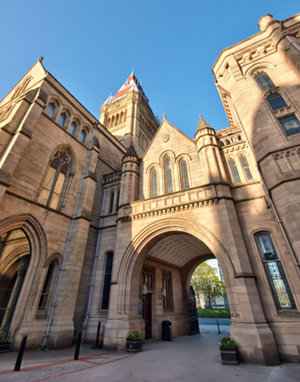UK-Germany National Astronomy Meeting NAM2012
Watching space weather through the MAGIC of CubeSat CINEMA
Royal Astronomical Society press release
RAS PR 12/15 (NAM 6)
Tuesday 27 March 2012
A trio of CubeSats that will study the effects of space weather on the Earth's radiation belts and magnetic field are being prepared for launch. TRIO-CINEMA is a collaboration between UC Berkeley, Kyung Hee University and Imperial College London. The first CINEMA CubeSat passed acceptance testing in January 2012 and will launch in mid-2012. Two more identical spacecraft will launch towards the end of the year. The mission will be presented by Professor Tim Horbury at the National Astronomy Meeting 2012 in Manchester on Tuesday 27th March.CINEMA will carry two science instruments: the SupraThermal Electron, Ion and Neutral (STEIN) sensor, provided by UC Berkeley, and the MAGIC magnetometer provided by Imperial College London. Both sensors represent technological leaps in miniaturised instrumentation and could have applications in a wide variety of space and planetary physics missions.
"CINEMA is part of the first generation of CubeSats to do world-class science," said Professor Bob Lin of UC Berkeley, who leads the CINEMA mission.
With a mass of just 500 grams, the tiny STEIN sensor will measure fast-moving charged and neutral particles and monitor the effects of magnetic storms, substorms, and particle precipitation on the Earth's magnetic field, radiation belts and auroral zones. STEIN builds on technology developed for NASA's STEREO solar mission, but is able to differentiate between ions, electrons, and energetic neutral atoms (ENAs).
"These types of particle detectors have been used before but have been limited in energy and time resolution. STEIN will be unique in its capacity to make high sensitivity maps and movies of ENAs," said Horbury, of Imperial College London. "CINEMA will be in Low Earth Orbit at an altitude of a few hundred kilometres above the Earth's surface, so STEIN will look upwards at the radiation belts. This will allow us to make longitudinal measurements around the Earth, and particularly to look at the energised tail of the Earth on the opposite side to the Sun."
The solar wind from the Sun hits the Earth's magnetic field, causing it to vary. Magnetometers allow scientists to monitor these small variations, which can have large effects on near-Earth space, accelerating particles to high energies which can ultimately harm satellites. The MAGIC instruments developed at Imperial are a new breed of magnetometer sensor that use a property called 'anisotropic magneto-resistance, in which the electrical resistance of a material depends on the angle between the electric current and the orientation of the magnetic field. From Low Earth Orbit, CINEMA will provide a crucial new measurement location between the magnetometers far from the Earth, such as those carried by the Cluster mission, and those on the ground. CINEMA will therefore provide an essential measurement to track the motion of these disturbances from the solar wind, through near-Earth space and to the ground, giving us the best ever picture of how they are formed, move and their effects on space around us."CINEMA will provide the first opportunity to use this technology in space science," said Horbury. "MAGIC works on a completely different system from the big magnetometers carried by missions such as Cluster, Cassini and Rosetta. Although the MAGIC instruments are less sensitive than traditional magnetometers, if you want to have a global picture of what's happening in the Earth's magnetosphere, you need to have a lot of spacecraft providing measurements. The sensor head for MAGIC is incredibly tiny - smaller than a £1 coin - so it's ideally suited to fly on constellations of CubeSats."
Kyung Hee University in South Korea, the third partner in CINEMA, is providing two more CubeSats identical to CINEMA. This CINEMA-TRIO mission will open up possibilities for stereoscopic imaging of neutral atoms and observations of the magnetic field in three dimensions.
"Additional funding has recently been secured from the NSF and the US Air Force to build a further CINEMA CubeSat, so in time there should be four in operation," said Horbury. "The satellites should remain in orbit for up to 20 years. However, as the electronics are off-the-shelf components rather than space grade components, it's uncertain how long they will remain operational."
The STEIN instrument needs accurate pointing so, in a further innovation, CINEMA will be the first spin stabilised CubeSat. The team in Berkeley has developed a complete attitude control system for CINEMA.
"This has been a huge undertaking but should prove a good investment for the future," said Horbury.
IMAGES
Images of CINEMA and the MAGIC sensor can be downloaded from: https://fileexchange.imperial.ac.uk/files/89cc6a93e7/CINEMAImages.zip
- Image 1: CINEMA boom. Credit: University of California Berkeley
- Image 2: CINEMA engineering model. Credit University of California Berkeley
- Image 3: CINEMA MAGIC sensor. Credit: Imperial College London
- Image 4: CINEMA spacecraft. Credit: University of California Berkeley
- Image 5: CINEMA testing. Credit: Imperial College London
- Image 6: CINEMA Silhouette. Credit: Imperial College London
MEDIA CONTACTS
NAM 2012 Press Office (0900 - 1730 BST, 27-29 March; 0900 - 1630 BST 30 March)
Room 3.214
University Place building
University of Manchester
Manchester
UK
Tel: +44 (0)161 306 7313
Dr Robert Massey
Royal Astronomical Society
Mob: +44 (0)794 124 8035
Email: rm@ras.org.uk
Anita Heward
Royal Astronomical Society
Mob: +44 (0)7756 034 243
Email: anitaheward@btinternet.com
Dr Klaus Jaeger
Pressereferent / Press Officer im Vorstand der Astronomischen Gesellschaft
Tel: +49 6221 528 379
Email: pressereferent@astronomische-gesellschaft.de
Dan Cochlin
Media Officer (Faculty of Engineering and Physical Sciences)
University of Manchester
Tel: +44 (0)161 275 8387
Email: daniel.cochlin@manchester.ac.uk
Dr Holly Thomas
Joint Astronomy Centre
Hilo, Hawaii
Tel: +1 808 961 3756
Email: h.thomas@jach.hawaii.edu
SCIENCE CONTACTS
Professor Timothy Horbury
Imperial College London
Tel: +44 (0)20 7594 7676
E-mail: t.horbury@imperial.ac.uk
NOTES FOR EDITORS
TRIO-CINEMA
UC Berkeley was awarded $890 000 by the US National Science Foundation to fund CINEMA. In the UK, the work has been funded as part of Imperial College London’s support from the Science and Technology Facilities Council together with funds from the European Space Agency’s Permanent Open Call for Technology Transfer Feasibility Study (POCS). Kyung Hee University has been awarded a grant from the Korean Government’s ‘World Class University’ programme to support TRIO. CINEMA will be launched as part of the NASA Educational Launch of Nanosatellites (ELaNa) programme. 16 undergraduate students have worked on CINEMA at Imperial during the course of the project.
Imperial College London has licensed Satellite Services Ltd. to develop MAGIC sensors on a commercial basis.
NAM 2012
Bringing together more than 900 astronomers and space scientists, the National Astronomy Meeting (NAM 2012) will take place from 27-30 March 2012 in the University Place conference centre at the University of Manchester in the UK. The conference is a joint meeting of the Royal Astronomical Society (RAS) and the German Astronomische Gesellschaft (AG) and is held in conjunction with the UK Solar Physics (UKSP: www.uksolphys.org) and Magnetosphere Ionosphere Solar Terrestrial (MIST: www.mist.ac.uk) meetings. NAM 2012 is principally sponsored by the RAS, AG, STFC and the University of Manchester.
The Royal Astronomical Society
The Royal Astronomical Society (RAS: www.ras.org.uk), founded in 1820, encourages and promotes the study of astronomy, solar-system science, geophysics and closely related branches of science. The RAS organises scientific meetings, publishes international research and review journals, recognizes outstanding achievements by the award of medals and prizes, maintains an extensive library, supports education through grants and outreach activities and represents UK astronomy nationally and internationally. Its more than 3500 members (Fellows), a third based overseas, include scientific researchers in universities, observatories and laboratories as well as historians of astronomy and others.
The Astronomische Gesellschaft (AG)
The Astronomische Gesellschaft (AG: www.astronomische-gesellschaft.de), founded in 1863, is a modern astronomical society with more than 800 members dedicated to the advancement of astronomy and astrophysics and the networking between astronomers. It represents German astronomers, organises scientific meetings, publishes journals, offers grants, recognises outstanding work through awards and places a high priority on the support of talented young scientists, public outreach and astronomy education in schools.
The Science and Technology Facilities Council
The Science and Technology Facilities Council (STFC: www.stfc.ac.uk) is keeping the UK at the forefront of international science and tackling some of the most significant challenges facing society such as meeting our future energy needs, monitoring and understanding climate change, and global security. The Council has a broad science portfolio and works with the academic and industrial communities to share its expertise in materials science, space and ground-based astronomy technologies, laser science, microelectronics, wafer scale manufacturing, particle and nuclear physics, alternative energy production, radio communications and radar. It enables UK researchers to access leading international science facilities for example in the area of astronomy, the European Southern Observatory.
Jodrell Bank Centre for Astrophysics
The Jodrell Bank Centre for Astrophysics (JBCA: www.jb.man.ac.uk) is part of the School of Physics & Astronomy at the University of Manchester. JBCA is split over two main sites: the Alan Turing Building in Manchester and the Jodrell Bank Observatory in Cheshire. At Jodrell Bank Observatory, the new Jodrell Bank Discovery Centre is a key focus for our work in public engagement and education. Jodrell Bank is a world leader in radio astronomy-related research and technology development with a research programme extending across much of modern astrophysics. The group operates the e-MERLIN national radio astronomy facility and the iconic Lovell Telescope, hosts the UK ALMA Regional Centre Node and is home to the international office of the SKA Organisation. Funded by the University, the Science & Technology Facilities Council and the European Commission, it is one of the UK's largest astrophysics research groups.
Imperial College London
Consistently rated amongst the world's best universities, Imperial College London is a science-based institution with a reputation for excellence in teaching and research that attracts 14,000 students and 6,000 staff of the highest international quality. Innovative research at the College explores the interface between science, medicine, engineering and business, delivering practical solutions that improve quality of life and the environment - underpinned by a dynamic enterprise culture.
Since its foundation in 1907, Imperial's contributions to society have included the discovery of penicillin, the development of holography and the foundations of fibre optics. This commitment to the application of research for the benefit of all continues today, with current focuses including interdisciplinary collaborations to improve global health, tackle climate change, develop sustainable sources of energy and address security challenges.
In 2007, Imperial College London and Imperial College Healthcare NHS Trust formed the UK's first Academic Health Science Centre. This unique partnership aims to improve the quality of life of patients and populations by taking new discoveries and translating them into new therapies as quickly as possible.
Website: www.imperial.ac.uk
Twitter: www.twitter.com/imperialspark
Podcast: www.imperial.ac.uk/media/podcasts





